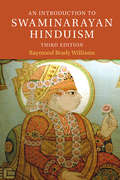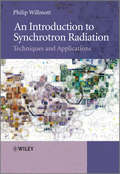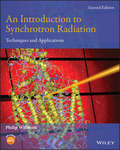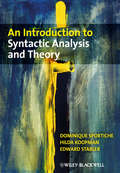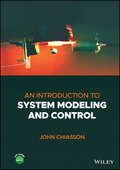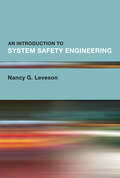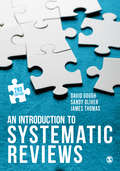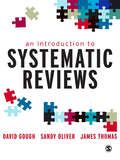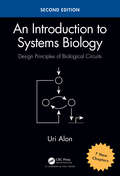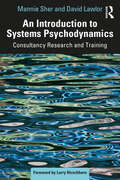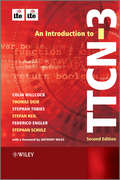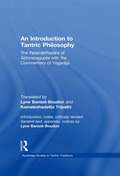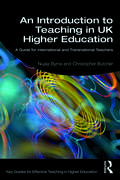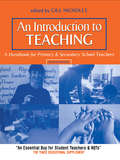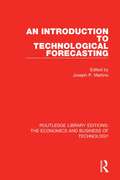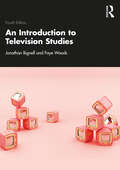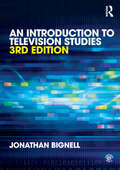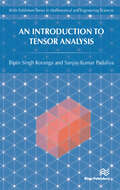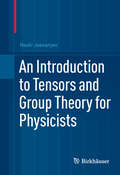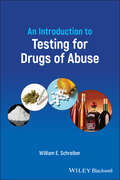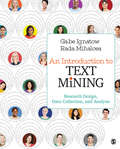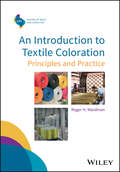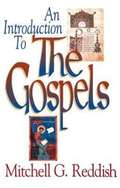- Table View
- List View
An Introduction to Swaminarayan Hinduism (Introduction to Religion)
by Raymond Brady WilliamsAn Introduction to Swaminarayan Hinduism, third edition, offers a comprehensive study of a contemporary form of Hinduism. Begun as a revival and reform movement in India 200 years ago, it has now become one of the fastest growing and most prominent forms of Hinduism. The Swaminarayan Hindu transnational network of temples and institutions is expanding in India, East Africa, the UK, USA, Australasia, and in other African and Asian cities. The devotion, rituals, and discipline taught by its founder, Sahajanand Swami (1781–1830) and elaborated by current leaders in major festivals, diverse media, and over the Internet, help preserve ethnic and religious identity in many modern cultural and political contexts. Swaminarayan Hinduism, here described through its history, divisions, leaders, theology and practices, provides valuable case studies of contemporary Hinduism, religion, migrants, and transnationalism. This new edition includes up-to-date information about growth, geographic expansion, leadership transitions, and impact of Swaminarayan institutions in India and abroad.
An Introduction to Synchrotron Radiation
by Philip WillmottThis book introduces the reader to the basic concepts of the generation and manipulation of synchrotron light, its interaction with matter, and the application of synchrotron light in the "classical" techniques, while including some of the most modern technological developments. As much as possible, complicated mathematical derivations and formulas are avoided. A more heuristic approach is adopted, whereby the general physical reasoning behind the equations is highlighted.Key features:A general introduction to synchrotron radiation and experimental techniques using synchrotron radiation Contains many detailed "worked examples" from the literature Of interest for a broad audience - synchrotrons are possibly one of the best examples of multidisciplinary research Four-colour presentation throughout
An Introduction to Synchrotron Radiation: Techniques and Applications
by Philip Willmott PhDThe updated guide to the fundamental concepts, techniques and applications of synchrotron radiation and its applications in this rapidly developing field Synchrotron light is recognized as an invaluable research tool by a broad spectrum of scientists, ranging from physicists to biologists and archaeologists. The comprehensively revised second edition of An Introduction to Synchrotron Radiation offers a guide to the basic concepts of the generation and manipulation of synchrotron light, its interaction with matter and the application of synchrotron light in x-ray scattering, spectroscopy, and imaging. The author, a noted expert in the field, reviews the fundamentals of important experimental methods, and explores the most recent technological advances in both the latest generation of x-ray sources and x-ray instrumentation. Designed to be an accessible resource, the book contains full-colour illustrations of the underlying physics and experimental applications, as well as the most commonly-used synchrotron techniques. In particular, the updated second edition now includes: In-depth descriptions of the latest x-ray-source technologies, notably diffraction-limited storage rings and x-ray free-electron lasers The latest advances in instrumentation, x-ray optics, and experimental methods in synchrotron radiation The most recent developments in macromolecular crystallography, time-resolved studies, and imaging techniques A comprehensive set of problems for each chapter, plus their ideal solutions in the appendices. Written for undergraduate and postgraduate students from all areas of the natural and physical sciences, An Introduction to Synchrotron Radiation, Second Edition is an invaluable up-to-date reference source in this highly multidisciplinary field.
An Introduction to Syntactic Analysis and Theory
by Dominique Sportiche Hilda Koopman Edward StablerAn Introduction to Syntactic Analysis and Theory offers beginning students a comprehensive overview of and introduction to our current understanding of the rules and principles that govern the syntax of natural languages. Includes numerous pedagogical features such as ‘practice’ boxes and sidebars, designed to facilitate understanding of both the ‘hows’ and the ‘whys’ of sentence structure Guides readers through syntactic and morphological structures in a progressive manner Takes the mystery out of one of the most crucial aspects of the workings of language – the principles and processes behind the structure of sentences Ideal for students with minimal knowledge of current syntactic research, it progresses in theoretical difficulty from basic ideas and theories to more complex and advanced, up to date concepts in syntactic theory
An Introduction to System Modeling and Control
by John ChiassonA practical and straightforward exploration of the basic tools for the modeling, analysis, and design of control systems In An Introduction to System Modeling and Control, Dr. Chiasson delivers an accessible and intuitive guide to understanding modeling and control for students in electrical, mechanical, and aerospace/aeronautical engineering. The book begins with an introduction to the need for control by describing how an aircraft flies complete with figures illustrating roll, pitch, and yaw control using its ailerons, elevators, and rudder, respectively. The book moves on to rigid body dynamics about a single axis (gears, cart rolling down an incline) and then to modeling DC motors, DC tachometers, and optical encoders. Using the transfer function representation of these dynamic models, PID controllers are introduced as an effective way to track step inputs and reject constant disturbances. It is further shown how any transfer function model can be stabilized using output pole placement and on how two-degree of freedom controllers can be used to eliminate overshoot in step responses. Bode and Nyquist theory are then presented with an emphasis on how they give a quantitative insight into a control system's robustness and sensitivity. An Introduction to System Modeling and Control closes with chapters on modeling an inverted pendulum and a magnetic levitation system, trajectory tracking control using state feedback, and state estimation. In addition the book offers: A complete set of MATLAB/SIMULINK files for examples and problems included in the book. A set of lecture slides for each chapter. A solutions manual with recommended problems to assign. An analysis of the robustness and sensitivity of four different controller designs for an inverted pendulum (cart-pole). Perfect for electrical, mechanical, and aerospace/aeronautical engineering students, An Introduction to System Modeling and Control will also be an invaluable addition to the libraries of practicing engineers.
An Introduction to System Safety Engineering
by Nancy G. LevesonA comprehensive, up-to-date introduction to the foundations of classical safety engineering, with an emphasis on preparing for future challenges.Systems today are orders of magnitude more complex than in the past, and their complexity is increasing exponentially. Preventing accidents and losses in such systems requires a holistic perspective that can accommodate unprecedented types of technology and design. This textbook teaches the foundations of classical safety engineering while incorporating the principles of systems thinking and systems theory. Beginning with the framing and lessons of her classic text, Safeware, Nancy Leveson builds on established knowledge and brings the field up to date, challenging old approaches and introducing new ones. This essential book provides the core information required to build safety-critical systems today and in the future, including coverage of the historical and legal frameworks in which the field operates as well as discussions of risk, ethics, and policy implications. Presents cutting-edge concepts anticipating the safety challenges of the future alongside thorough treatment of historical practices and ideasProvides a comprehensive introduction to the foundations of safety engineeringCovers accident analysis, hazard analysis, design for safety, human factors, management, and operationsIncorporates extensive examples of real-world accidents and applications Ideal for students new to safety engineering as well as professionals looking to keep pace with a rapidly changing field
An Introduction to Systematic Reviews
by James Thomas Sandy Oliver David GoughFocused on actively using systematic review as method, this book provides clear, step-by-step advice on the logic and processes of systematic reviewing. Stressing the importance of precision and accuracy, this new edition carefully balances a need for insightful theory with real-world pragmatism; it introduces a wide range of cutting-edge approaches to research synthesis including text mining, living reviews and new ideas in mixed methods reviews such as qualitative comparative analysis. The book also includes: A new chapter on statistical synthesis Coverage of computer-assisted methods and relevant software Expanded sections on data extraction and management A guide to working with many different types of data including longitudinal and panel. Packed with examples from across the social sciences, this book helps students and researchers alike in turning systematic reviews into recommendations for policy and practice.
An Introduction to Systematic Reviews
by James Thomas Sandy Oliver David GoughFocused on actively using systematic review as method, this book provides clear, step-by-step advice on the logic and processes of systematic reviewing. Stressing the importance of precision and accuracy, this new edition carefully balances a need for insightful theory with real-world pragmatism; it introduces a wide range of cutting-edge approaches to research synthesis including text mining, living reviews and new ideas in mixed methods reviews such as qualitative comparative analysis. The book also includes: A new chapter on statistical synthesis Coverage of computer-assisted methods and relevant software Expanded sections on data extraction and management A guide to working with many different types of data including longitudinal and panel. Packed with examples from across the social sciences, this book helps students and researchers alike in turning systematic reviews into recommendations for policy and practice.
An Introduction to Systematic Reviews
by James Thomas Sandy Oliver Dr David GoughThis timely, engaging book provides an overview of the nature, logic, diversity and process of undertaking systematic reviews as part of evidence informed decision making. A focused, accessible and technically up-to-date book, it covers the full breadth of approaches to reviews from statistical meta analysis to meta ethnography. It is ideal for anyone undertaking their own systematic review - providing all the necessary conceptual and technical background needed to make a good start on the process. The content is divided into five clear sections: * Approaches to reviewing * Getting started * Gathering and describing research * Appraising and synthesising data * Making use of reviews/models of research use. Easy to read and logically structured, this book is essential reading for anyone doing systematic reviews. David Gough is Professor of Evidence Informed Policy and Practice and Director of SSRU and its EPPI-Centre and Co-Editor of the journal Evidence & Policy. Sandy Oliver is Professor of Public Policy and Deputy Dirctor of SSRU and its EPPI-Centre. James Thomas is Reader in Social Policy, Assistant Director of SSRU and Associate Direcctor of the EPPI-Centre.
An Introduction to Systems Biology: Design Principles of Biological Circuits, Second Edition (Chapman & Hall/CRC Mathematical and Computational Biology)
by Uri AlonPraise for the first edition: … superb, beautifully written and organized work that takes an engineering approach to systems biology. Alon provides nicely written appendices to explain the basic mathematical and biological concepts clearly and succinctly without interfering with the main text. He starts with a mathematical description of transcriptional activation and then describes some basic transcription-network motifs (patterns) that can be combined to form larger networks. – Nature [This text deserves] serious attention from any quantitative scientist who hopes to learn about modern biology … It assumes no prior knowledge of or even interest in biology … One final aspect that must be mentioned is the wonderful set of exercises that accompany each chapter. … Alon’s book should become a standard part of the training of graduate students. – Physics Today Written for students and researchers, the second edition of this best-selling textbook continues to offer a clear presentation of design principles that govern the structure and behavior of biological systems. It highlights simple, recurring circuit elements that make up the regulation of cells and tissues. Rigorously classroom-tested, this edition includes new chapters on exciting advances made in the last decade. Features: Includes seven new chapters The new edition has 189 exercises, the previous edition had 66 Offers new examples relevant to human physiology and disease
An Introduction to Systems Psychodynamics: Consultancy Research and Training
by Mannie Sher David LawlorThis book provides an introduction to systems psychodynamic theory and its application to organisational consultancy, research and training, outlining systems dynamics methods and their historical and theoretical developments. Systems Psychodynamics is an emerging field of social science, the boundaries of which are continually being refined and re-defined. The ‘systems’ designation refers to open systems concepts that provide the framing perspective for understanding the structural aspects of organisational systems. These include its design, division of labour, levels of authority, and reporting relationships; the nature of work tasks, processes, and activities; its mission and primary task; and the nature and patterning of the organisation’s task and sentient boundaries and the transactions across them. This book presents a critical appraisal of the systems psychodynamics paradigm and its application to present-day social and organisational difficulties, showing how a holistic approach to organisational and social problems can offer a fresh perspective on difficult issues. Bringing together the theory and practice of systems psychodynamics for the first time, this book provides an examination of the systems psychodynamics paradigm in action. This book gives an accessible and thorough guide to understanding and using systems psychodynamic ideas for analysts, managers, policy makers, consultants and researchers in a wide range of professional and clinical settings.
An Introduction to TTCN-3
by Colin Willcock Thomas Deiß Stephan Tobies Federico Engler Anthony Wiles Stefan Keil Stephan SchulzThis unique book provides a fully revised and up-to-date treatment of the TTCN-3 language TTCN-3 is an internationally standardised test language with a powerful textual syntax which has established itself as a global, universal testing language. Application of TTCN-3 has been widened beyond telecommunication systems to areas such as the automotive industry, internet protocols, railway signalling, medical systems, and avionics.An Introduction to TTCN-3 gives a solid introduction to the TTCN-3 language and its uses, guiding readers though the TTCN-3 standards, methodologies and tools with examples and advice based on the authors' extensive real-world experience. All the important concepts and constructs of the language are explained in a step-by-step, tutorial style, and the authors relate the testing language to the overall test system implementation, giving the bigger picture.This second edition of the book has been updated and revised to cover the additions, changes and extensions to the TTCN-3 language since the first version was published. In addition, this book provides new material on the use of XML, test framework design and LTE testing with TTCN-3.Key Features:Provides a fully revised and up-to-date look at the TTCN-3 language Addresses language standardization, tool implementation and applying TTCN-3 in real world scenarios such as VoIP and LTE testing Explores recent advances such as TTCN-3 core language extensions on type parameterization, behavior types, real time and performance testing Introduces the use of ASN.1 and XML with TTCN-3 Written by experts in the field Includes an accompanying website containing code samples and links to the relevant standards documents (www.wiley.com/go/willcock_ttcn-3_2e) This book is an ideal reference for test engineers, software developers, and standards professionals. Graduate students studying telecommunications and software engineering will also find this book insightful.
An Introduction to Tantric Philosophy: The Paramarthasara of Abhinavagupta with the Commentary of Yogaraja (Routledge Studies in Tantric Traditions)
by Lyne Bansat-Boudon Kamalesha Datta TripathiThe Paramārthasāra, or ‘Essence of Ultimate Reality’, is a work of the Kashmirian polymath Abhinavagupta (tenth–eleventh centuries). It is a brief treatise in which the author outlines the doctrine of which he is a notable exponent, namely nondualistic Śaivism, which he designates in his works as the Trika, or ‘Triad’ of three principles: Śiva, Śakti and the embodied soul (nara). The main interest of the Paramārthasāra is not only that it serves as an introduction to the established doctrine of a tradition, but also advances the notion of jiv̄anmukti, ‘liberation in this life’, as its core theme. Further, it does not confine itself to an exposition of the doctrine as such but at times hints at a second sense lying beneath the evident sense, namely esoteric techniques and practices that are at the heart of the philosophical discourse. Its commentator, Yogarāja (eleventh century), excels in detecting and clarifying those various levels of meaning. An Introduction to Tantric Philosophy presents, along with a critically revised Sanskrit text, the first annotated English translation of both Abhinavagupta’s Paramārthasāra and Yogarāja’s commentary. This book will be of interest to Indologists, as well as to specialists and students of Religion, Tantric studies and Philosophy.
An Introduction to Teaching in UK Higher Education: A Guide for International and Transnational Teachers (Key Guides for Effective Teaching in Higher Education)
by Christopher Butcher Nuala ByrneCovering everything you need to know about teaching within the UK higher education system, this book is the ideal introduction for anyone looking to start their teaching career. A must-read guide for international staff new to teaching in UK higher education, this key text focuses on what is particular and often baffling to those who are new to higher education teaching in the UK. With practical tips and advice rooted in relevant theory, it is an invaluable resource to guide you through the initial teaching experience. Breaking down all of the aspects involved in teaching, learning and assessing in UK higher education, this book covers: The key features of UK higher education – particularly how it might differ from other systems How courses and the curriculum are designed How to support learning within your teaching practice Advice on marking and giving worthwhile feedback How to develop your own professional practice A full glossary of key terms An Introduction to Teaching in UK Higher Education is a one-stop resource for those looking to begin a career in UK higher education. Particularly useful for new international staff, it will also be of interest to those looking to improve their teaching practice.
An Introduction to Teaching: A Handbook for Primary and Secondary School Teachers
by Gill NichollsThe expectations of what it is to be a teacher are as high as ever. An Introduction to Teaching, which is the second edition of the well-established textbook Learning to Teach, provides a fully up-to-date introduction to the process and practice of teaching, and the personal and professional skills that successful teaching requires. This comprehensive update of the first edition is written in accordance with the Teacher Training Association and DfES guidelines, and provides in-depth coverage of all the modules included in the teacher training programme. Taking into account recent developments in policy and practice, contributors have incorporated new material covering teaching and classroom management, new approaches to planning, targeting effective learning, introduction to professional requirements and continuing professional development.The book also includes key chapters on the following: the National Curriculum children's learning the use of IT planning and preparation teaching and classroom management special educational needs working with parents.
An Introduction to Technological Forecasting (Routledge Library Editions: The Economics and Business of Technology #31)
by Joseph P. MartinoOriginally published in 1972 this book examines technological forecasting and assesses its merits and limitations and possible uses for society, government, industry and the military. Although technological forecasting was in its infancy when this book was originally published, it has now become part of mainstream social and economic planning.
An Introduction to Television Studies
by Jonathan Bignell Faye WoodsThis comprehensive textbook, now substantially updated for its fourth edition, provides students with a framework for understanding the key concepts and main approaches to Television Studies, including audiences, representation, industry and global television, as well as the analytical study of individual programmes. This new edition reflects the significant changes the television industry is undergoing in the streaming era with an explosion of new content and providers, whilst also identifying how many existing practices have endured. The book includes a glossary of key terms, with each chapter suggesting further reading. New and updated material includes: Chapters on style and form, narrative, industry, and representation and identity Case studies on Bon Appétit’s YouTube channel, Insecure, British youth television, ABC and Disney+, fixed-rig observational documentary, streaming platforms' use of data to shape audience experience, Chewing Gum, Korean drama and The Marvelous Mrs Maisel Sections on medical drama, YouTube creators, Skam and scripted format sales, the global spread of streaming platforms, prestige TV and period drama With individual chapters addressing television style and form, narrative, histories, industries, genres and formats, realities, production, audiences, representation and identity, and quality, this book is essential reading for both students and scholars of Television Studies.
An Introduction to Television Studies
by Jonathan BignellIn this comprehensive textbook, now updated for its third edition, Jonathan Bignell provides students with a framework for understanding the key concepts and main approaches to Television Studies, including audience research, television history and broadcasting policy, and the analytical study of individual programmes. Features include: a glossary of key terms key terms defined in margins suggestions for further reading activities/assignments for use in class New and updated case studies feature: ‘Every Home Needs a Harvey’ ad approaches to news reporting television scheduling CSI Crime Scene Investigation animated cartoon series Individual chapters address: studying television, television histories, television cultures, television texts and narratives, television genres and formats, television production, television and quality, television realities, television you can’t see, television audiences, beyond television.
An Introduction to Tensor Analysis
by Bipin Singh Koranga Sanjay Kumar PadaliyaThe subject of Tensor Analysis deals with the problem of the formulation of the relation between various entities in forms which remain invariant when we pass from one system of coordinates to another. The invariant form of equation is necessarily related to the possible system of coordinates with reference to which the equation remains invariant. The primary purpose of this book is the study of the invariance form of equation relative to the totally of the rectangular co-ordinate system in the three-dimensional Euclidean space. We start with the consideration of the way the sets representing various entities are transformed when we pass from one system of rectangular co-ordinates to another. A Tensor may be a physical entity that can be described as a Tensor only with respect to the manner of its representation by means of multi-sux sets associated with different system of axes such that the sets associated with different system of co-ordinate obey the transformation law for Tensor. We have employed sux notation for tensors of any order, we could also employ single letter such A,B to denote Tensors.
An Introduction to Tensors and Group Theory for Physicists
by Nadir JeevanjeeAn Introduction to Tensors and Group Theory for Physicists provides both an intuitive and rigorous approach to tensors and groups and their role in theoretical physics and applied mathematics. A particular aim is to demystify tensors and provide a unified framework for understanding them in the context of classical and quantum physics. Connecting the component formalism prevalent in physics calculations with the abstract but more conceptual formulation found in many mathematical texts, the work will be a welcome addition to the literature on tensors and group theory. Advanced undergraduate and graduate students in physics and applied mathematics will find clarity and insight into the subject in this textbook.
An Introduction to Testing for Drugs of Abuse
by William E. SchreiberAn Introduction to Testing for Drugs of Abuse An Introduction to Testing for Drugs of Abuse presents a distilled set of facts about the major drugs of abuse that are encountered in clinical practice. Individual chapters highlight the similarities in chemical structure, mechanism of action, and physiologic effects of each drug group, as well as their metabolism, therapeutic uses and potential for misuse or abuse. Special attention is given to the testing process, with an emphasis on interpretation of test results. Informative and entertaining cases appear at the end of each chapter. These cases illustrate the many situations in which drug testing is performed for medical, legal and employment purposes. Written in clear, concise language, this book provides practical guidance to pathologists, clinical chemists and technologists who are responsible for reporting and interpreting the results of drug analyses. It will be especially useful to residents and students who are learning about toxicology for the first time. Clinical practitioners – doctors, nurses, pharmacists and other health care professionals – will find the information they need to order and interpret drug tests accurately.
An Introduction to Text Mining: Research Design, Data Collection, and Analysis
by Gabe Ignatow Rada F. MihalceaThis is the ideal introduction for students seeking to collect and analyze textual data from online sources. It covers the most critical issues that they must take into consideration at all stages of their research projects.
An Introduction to Text Mining: Research Design, Data Collection, and Analysis
by Gabe Ignatow Rada F. MihalceaThis is the ideal introduction for students seeking to collect and analyze textual data from online sources. It covers the most critical issues that they must take into consideration at all stages of their research projects.
An Introduction to Textile Coloration: Principles and Practice
by Roger H. WardmanAn Introduction to Textile Coloration: Principles and Practice The Publications Committee of the Society of Dyers and Colourists (SDC) has been aware for some time of the need to produce a book at an introductory level aimed at personnel working in textile dyeing or printing companies as well as those interested in entering into the field. The SDC runs a course for dyehouse technicians leading to the award of its Textile Coloration Certificate and this book is intended to be helpful for candidates following the course. Additionally, it will be helpful for professionals in textile companies who do not have a strong scientific background, so that they may attain a better understanding of the chemical principles of colour application. Starting with the basic science underlying dyeing and printing processes, this comprehensive book explains the fundamentals of dye and pigment chemistry and the various application techniques and processes. It offers chapter coverage of the general chemistry related to textiles, textile fibres, chemistry of dyes and pigments, industrial coloration methods, textile printing, theoretical aspects of dyeing, the measurement of colour and fastness testing. Reference is made to developments that have taken place in the coloration industry in recent years, not least of which have been the challenges imposed by the drive towards environmentally-friendly processes and restrictions on the use of certain chemicals. An Introduction to Textile Coloration: Principles and Practice Covers atomic structure, chemical reactions, and acids, bases, and salts Explains the nature of fibre-forming polymers and the conversion of synthetic polymers into fibre filaments Educates on the classification of colorants and the commercial naming of dyes and pigments Introduces readers to the dye application processes and dyeing machinery Instructs on dye aggregation, factors affecting colour appearance, the principles of colour fastness testing, and more
An Introduction to The Gospels
by Mitchell G. ReddishAn Introduction to the Gospels is designed to be a textbook for courses on the Gospels, for use at the college and beginning seminary level. Reflecting the most recent scholarship and written in an accessible style, the volume covers all four of the Gospels, including a survey of "the world of the Gospels".The book opens with a discussion of the origin, development, and interrelationships of the Four Gospels. After a chapter-length treatment of each canonical Gospel and the non-canonical Gospels, the work concludes with a discussion of the "historical Jesus" debate.In An Introduction to the Gospels, Mitchell G. Reddish: - provides a solid, convenient survey of the Gospels in an accessible textbook format- presents up-to-date scholarship in a field that has been dominated by older texts- gives a balanced presentation of the content of the Gospels
